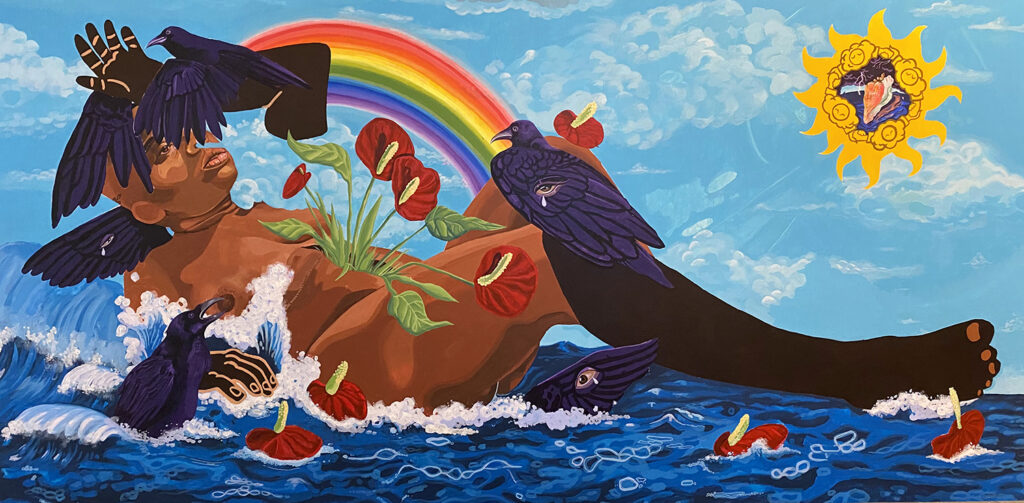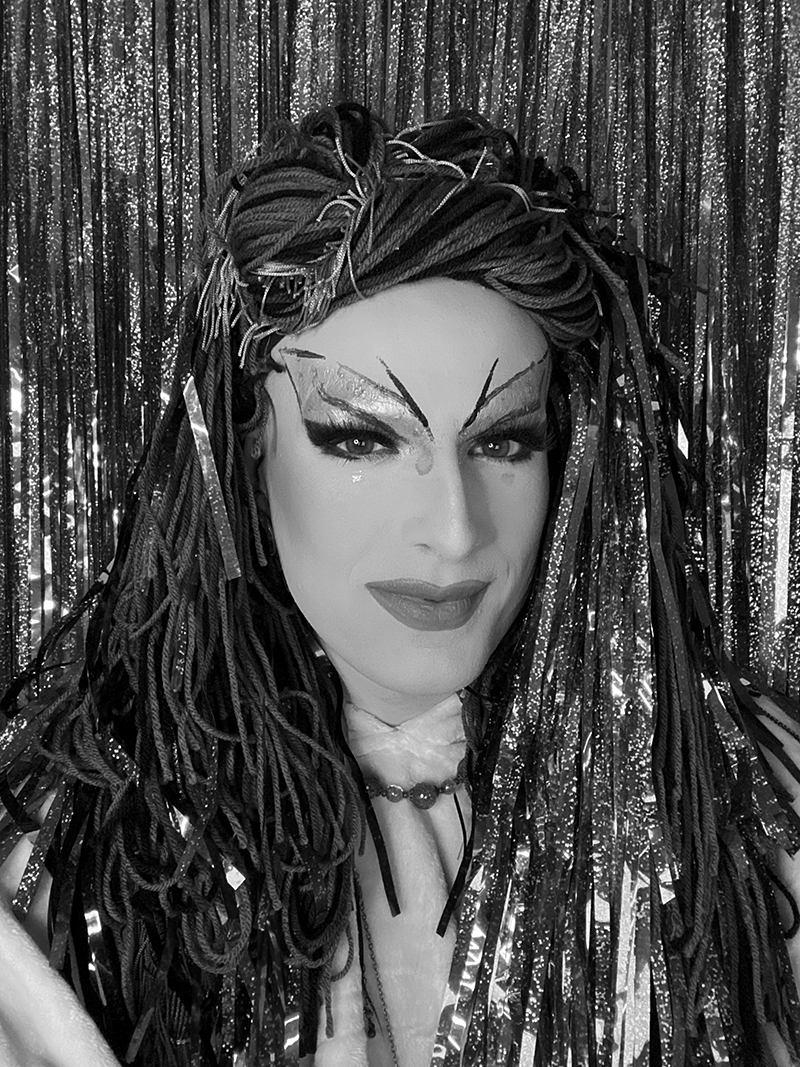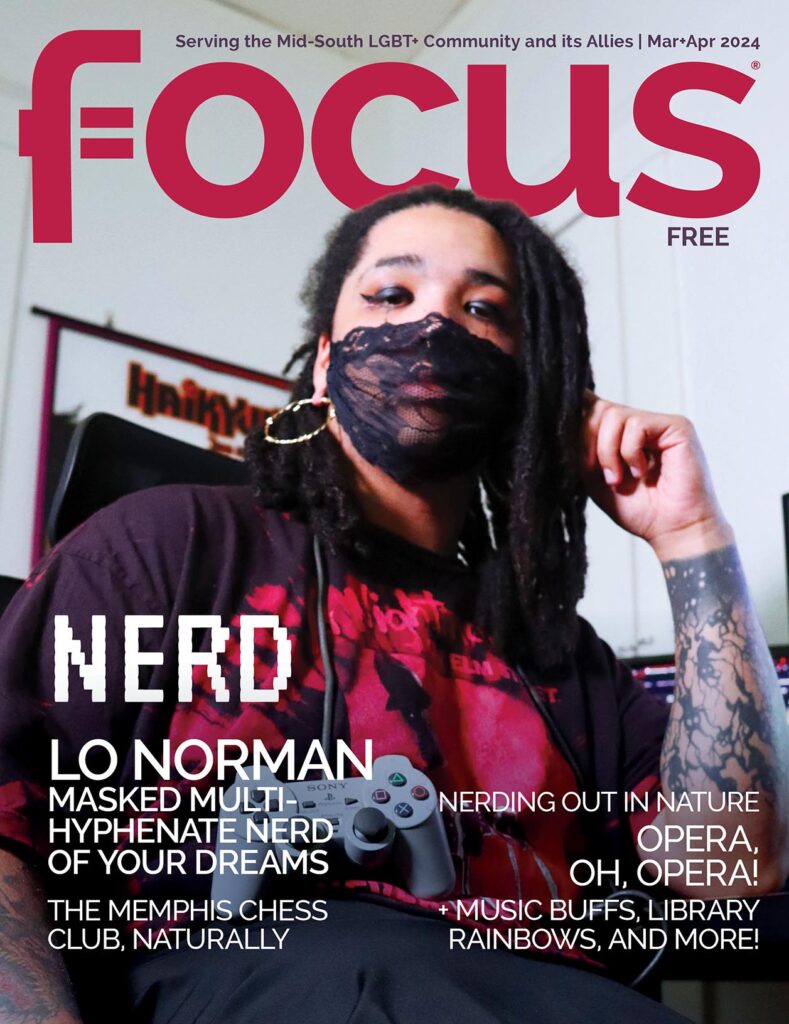by Moth Moth Moth | photo by Marcus Menefee
There is a marvelous person staring back at me from my kitchen table. It’s early February 2022, and this is far from the first kitchen table I’ve sat at with Amber Ahmad.
Amber started one year after me at Memphis College of Art (MCA). I can say that I remember exactly when we met, that there was a singular moment when we dreamily waltzed into one another’s lives and have been close friends ever since.
Art college kids have a weird bond. Like we all hail from the island of misfit toys.
There was a time when I would meet Amber in a computer lab in some converted hallway at the college – wherein we would catch up and compartmentalize between the bouts of sheer chaos and madness of our school days. Imagine a twink on the floor devouring a vile vegan honey bun from a vending machine while Amber finishes a drawing on the computer for a class later. Back then they were known for having amazing hair and a sonorous voice.
Now as we sit at a mermaid table in my East Memphis home, next to a window, Amber is as striking a character as ever. And becoming renowned for their work as a painter. They visited me to be interviewed and speak about their work. We are both grownup professional folks now. Which absolutely did not keep us from spending a portion of the interview reminiscing about our school days. But perhaps MCA is a good jumping off point. Let’s rewind a little.
Amber Ahmad is a Memphian, born and raised. The youngest among three siblings. Art throughout high school. Trained in the illustration program at MCA then self-taught as a painter postgrad. A curator by day, they are an emerging artist themself, standing in the intersections of blackness, queerness, the cutting edge, immediacy, intimacy, trauma, and freak cool people who are genius.
After a wildly successful first solo show at NADA Miami this past winter — Ahmad is radiant, having not only sold work but found patrons and avenues of exposure. Pieces from this show are all available to see on Ahmad’s Instagram and website. But the true colors and textures belong with the artist’s memory and the buyer’s collections now.
If you ask the tribe of contacts that surround Ahmad you will only find this, an individual of talent and presence, someone we are all incredibly proud of. There isn’t a drop of jealousy from any mouth. We have already known what the world is coming to know.
Amber Ahmad is the artist to watch.
MOTHIE: So painting is your mantle, your main medium.
AHMAD: Painting is my medium, even when I offshoot — it involves painting. I’ll do wood cutouts of figures and paint figures on the wood, I did that for a residency show. I’ve painted on plexiglass cutouts I made in the Crosstown Artspace. Or like right now I’m doing a whole painting on polytab which is a kind of mural cloth–when you paste it onto a surface it looks like it is painted on. It’s durable and doesn’t take up tons of space. I’ve had to be flexible with my materials and space since I’ve had to move like three times in the past couple of years. The place where I am now is my first studio space that does not have bugs, raccoons, and cats running out of it.
The process with the polytab really helped with the work for the Miami show. It’s cheap and you just need acrylic glaze and to squeegee it like real tight and it looks seamless. People often ask what part of this is collage–it looks very flat!
Ahmad has cultivated their techniques from experimentation, residency training, and just plain making it all work. Finding materials that complement life [and it’s circumstances!] is often one of the hardest boundaries. It sounds like Ahmad has found democratic materials for their work while having fun and venturing out.
The paintings themselves explore mythology and divinity through expression but are also rich in prismatic colors and moments that feel whimsical. But whimsical in the way that Paris runways are whimsical– there is still always a cut to the work. Something that draws the viewer in.

Tell me about the work right now.
All of this is an offshoot of a time when I began to paint for myself. Most of what we are talking about are offshoots from a body of work called “Free 99.” I was like “I’ve been in a handful of gallery shows now it’s time for me to make a conceptual series or whatever. I was just coming off a stint where I was making work about recent past traumas and at this point I was like “I don’t wanna do that anymore” -but laughs beautifully you don’t decide when you’re done making something. And that is hard when it comes time to price the work, trying to price these really intimate events in my life. How do I price these things that have happened to me? How can I move these intimate works in a consumerist setting?
What do you get out of making the work? What is in it that is just in it for you, when there are no stakes for anybody else?
I think bringing it into the world is what’s in it for me. Because I have too many ideas. I don’t feel burdened by my ideas in a destructive way. I used to get down about having all these ideas and sketchbooks but it’s all come together. It all came together. And some things don’t need to be made even two years down the line.
Right? Some things aren’t meant to be made, sometimes a fun idea for a thing can be just that.
Or sometimes it’s not a fun idea and it would hurt you to do. Putting expectations of healing on my painting practice stifled me for a while. I would try to tackle these hard subjects like sexual assault and maybe I wouldn’t be ready for it. And I would be trying to use the painting as the therapy to the thing or whatever and that was such a big expectation to put on the work.
The last painting I did was 80+ hours. I have to ask myself if I want to think about this subject for 80+ hours?
It’s true that our art remakes us. Sometimes what people are purchasing is the remnant or the artifact of an experience an artist had within themselves.
What comes with letting go of a piece?
It used to be very postpartum. Now that I’m more integrated into the fine art world it’s less severe. Every piece is like a baby. I only do personal work. It used to be hard–a stranger could buy it and leave it in a corner. And still, I do want it on the wall and I want people to be able to enjoy that thing. But now paintings are a little bit like stock and the patrons are buying stock in my work and career. If I don’t want to sell I don’t have to sell if it’s a piece I
can’t put a dollar amount to.
The way I’m approaching these narrative paintings–since I’m working through everything in therapy outside, alongside, the actual paintings instead of relying on the painting–has been healthier. Artists have a lot of control over who collects them. So maybe sometimes I would rather this person, who has to pay in two installments, have it, rather than someone who can pay up front, because that first person bonded with the work more. Recently I’ve sold to people who are really into the work, I’m excited for it to be on their wall.

Let’s change gears. How has queerness effected your work?
The more queer I got, the more interested in folklore and mythology I got.
Very into alchemy and alchemical symbology. In my research I’ve looked at a lot of illuminated manuscripts, old kooky Christian mystic stuff. Been looking into the differences in Chinese alchemy. And trying to make all of that into something for the world.
I was in a show called “Fiber,” it was a show for–at the time– all women and it was about challenging the male gaze in terms of the experience of black women artists in America.
So I painted myself as these two harpies. I was blending my body with animal parts more and more because I wasn’t understanding what was going on inside of me at the time. I wasn’t identifying as non-binary just yet. I was like I know I’m not a cis woman but I don’t want to be a cis man either. But I knew I wanted the power that cis men have. So all of that led me to researching and learning more about gender expressions, as well as more antiquity and folklore. It began to be a mixing of selves and not as much separate body parts. I felt very disconnected from being a human for a while. Like if I’m not a woman, what am I? I think that is where the animal parts and the becoming mythical beasts came from.
Mythology contains so much queerness that didn’t get written out of history. Myth, folklore, alchemy all contain pieces of our collective queer history.
To round it out, one of the magnum opuses of alchemy is iron into gold, rain into a rainbow, and the man and woman into the divine hermaphrodite. The Rebis is the divine hermaphrodite to bring balance, it’s the idea of someone not being male or female but both or neither. Of course now we aren’t thinking about existing on a binary but it shows people have always been thinking about this. Someone was thinking too, maybe it’s not one or the other, maybe it’s all happening at the same time. Maybe the magnum opus is showing up how you need to.
*Slams table* What do you want? What do you want out of your time moving forward?
I want to be free. When I say free I say I want to be free to do painting as a living.
Whether I’m with a gallery or just selling these out of my studio. I want to support my partner and cat and myself. I want peace and I want a house on some land with a studio with ducks and my cat and I want to help other artists get to a secure point.
No matter where you may be on the road between iron and gold, know that there are other dazzling smart, cool, genius queers out there chewing on the same things you are. We create our mythology together now. I think Amber Ahmad is proof of that.




